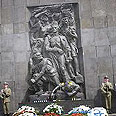
Poland's new Jewish museum to mark community's thousand-year history
Jewish leaders, Polish president to break ground for new museum of Polish Jews history from 10th century on . 'It will be a museum of life,' says president of Jewish historical institute
Jewish leaders and President Lech Kaczynski will break ground Tuesday for the Museum of the History of Polish Jews.
It sits on a highly charged site – next to the city's monument to the Jews who resisted the Nazis during the 1943 ghetto uprising, and just down the street from the rail siding where many were deported to their deaths.
The multimedia museum will have exhibits on the Holocaust, but organizers say its primary purpose is to remember the vibrant Jewish community that flourished in Poland for a thousand years through varying degrees of anti-Semitism and discrimination.
Vibrant community
"This will not be another Holocaust museum," said Marian Turski, one of the originators of the idea for the museum, and president of the Association of the Jewish Historical Institute in Poland. "It will be a museum of life."
The building, an austere glass and limestone structure designed by Finnish architects Rainer Mahlamaki and Ilmari Lahdelma, will feature a jagged chasm that cuts through the entire museum, and an interior of undulating forms that alludes to Moses' parting of the Red Sea while fleeing slavery in Egypt - symbolic of Jewish survival in the face of catastrophe.
When it opens in two years, Polish and Jewish leaders hope it will become a cultural landmark in a league with Jerusalem's Yad Vashem, the United States' Holocaust Memorial Museum in Washington and Berlin's Jewish Museum and Holocaust Memorial.
To many, such a center is long overdue in a country that had Europe's largest Jewish community until World War II, numbering about 3.3 million, or 10 percent of the total population.
Poland is also where Nazi Germany built Auschwitz, Treblinka and the other extermination camps where six million Jews - half of them Polish - were killed. Only about 30,000 Jews live in Poland today.
The theater experience
Museum creators say the project will chronicle the fate of Jews in their Eastern European homeland with interactive and multimedia displays and video - not just traditional artifacts and exhibits - in order to give visitors a deeper sense of what was lost.
"It's closer in many ways to theater than it is to a didactic display based on a collection," said Barbara Kirshenblatt-Gimblett, an American scholar leading an international team developing the exhibition, who is also a specialist in East European Jewish culture and museum development with New York University.
Eight galleries will narrate a story starting in the 10th century when Ibrahim ibn Jakub, a Jewish merchant from Arab Spain, first arrived in the Polish kingdom.
A complex spectrum
The experts working on the displays say they are struggling with the sensitive question of how to depict
Polish-Jewish relations in a land that was at different times a place of tolerance for Jews, and of painful
anti-Semitism, discrimination and segregation.
The goal, said Gimblett, is to show the complex spectrum of relations.
The final rooms are devoted to the Holocaust, with a focus on the suffering of the Warsaw ghetto, as well as the postwar period, which saw pogroms and state-sponsored anti-Semitism.
It finishes on a hopeful note by showing a revival of Jewish life and new tolerance of the young Polish democracy - an openness that is itself a key factor in making the US $65 million project possible.










